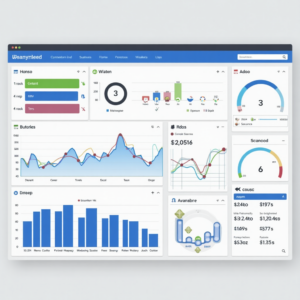
Introduction to CodeIgniter Dashboard Development
CodeIgniter is a powerful PHP framework used for building dynamic web applications. One of the key features of CodeIgniter is its ability to create custom dashboards for effective data management and visualization. In this article, we will explore the process of CodeIgniter dashboard development and the various tools and techniques used to create a user-friendly and efficient dashboard.
Benefits of CodeIgniter Dashboard Development
CodeIgniter dashboard development offers several benefits, including improved data visualization, enhanced user experience, and increased productivity. A well-designed dashboard provides a centralized platform for accessing and managing data, making it easier to analyze and make informed decisions. Additionally, CodeIgniter’s modular architecture and extensive libraries make it an ideal choice for building custom dashboards.Some of the key benefits of CodeIgniter dashboard development include:Improved data visualization and analysisEnhanced user experience and engagementIncreased productivity and efficiencyCustomizable and scalable architecture

Step-by-Step Guide to CodeIgniter Dashboard Development
To get started with CodeIgniter dashboard development, follow these steps:Step 1: Install CodeIgniter and setup the basic configurationStep 2: Plan the dashboard layout and designStep 3: Create the database and define the data modelsStep 4: Build the dashboard components and featuresStep 5: Test and deploy the dashboardBy following these steps, you can create a fully functional and customized dashboard using CodeIgniter.
Tools and Technologies Used in CodeIgniter Dashboard Development
CodeIgniter dashboard development involves the use of various tools and technologies, including:PHP and MySQL for backend developmentHTML, CSS, and JavaScript for frontend developmentCodeIgniter framework and its extensive librariesDatabase management systems such as MySQL and MongoDBVersion control systems such as Git and SVNBy leveraging these tools and technologies, you can create a robust and scalable dashboard that meets your specific needs and requirements.
Best Practices for CodeIgniter Dashboard Development
To ensure successful CodeIgniter dashboard development, follow these best practices:Keep the code organized and modularUse secure and validated user inputOptimize database queries and performanceUse responsive and mobile-friendly designTest and debug the code thoroughlyBy following these best practices, you can create a high-quality and efficient dashboard that provides a great user experience.
Conclusion
In conclusion, CodeIgniter dashboard development is a powerful and flexible way to create custom dashboards for effective data management and visualization. By following the steps outlined in this article and leveraging the various tools and technologies available, you can create a robust and scalable dashboard that meets your specific needs and requirements. Remember to follow best practices and keep the code organized, secure, and optimized for performance.